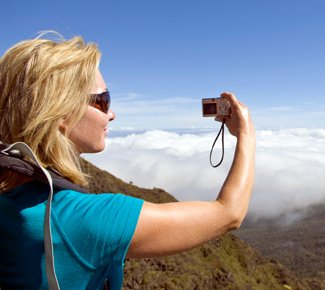Photography tips: the ultimate hiking kit

John Wallace has been in the business of choosing the right gear for more than 20 years. A photographer himself, John now manages Foto Riesel camera store in Sydney but has also worked for giants within the industry including Nikon, Sony and Konica Minolta.
Lugging around a 5kg camera kit when you’re out bushwalking can be a huge pain – not to mention redundant if you run out of batteries of have lens issues. The biggest piece of advice here is to keep things light – and get the best quality you can in a small camera. Here are some useful tips for packing the ultimate camera kit for getting outdoors:
The camera:
1. You need a good sensor for DSLR-quality pics but one that comes in a tiny lightweight body to keep your overall pack light. You have enough to carry with food, emergency supplies, water, so you need a camera that can perform but with just a fraction of the weight. Micro four-thirds cameras are ideal for this.
2. Interchangeable lenses are also worthwhile. There’s no point walking all this way to see stunning scenery but you don’t have the lenses in your kit to capture it.
3. Wide-angle lenses are recommended to capture beautiful landscapes but we want to keep the whole package small enough to fit in jacket pocket.
4. Durability is key. I recommend looking for a camera with a metal body to take the bumps and knock of trekking.
5. Full HD video is also a bonus to capture those once-In-a-lifetime trekking moments in motion.
Accessory lens:
1. You’ll want the best optics for the ultimate in tonal range and sharpness. You’ve trekked all this way – don’t go home with inferior pictures.
2. Your lenses need to be tough, reliable and up to the job. They need to be able to perform well in extreme conditions. Well-made, metal-cased lenses are expensive, but will last the distance.
3. Getting the best shots in low light is also a priority. Think of those amazing sunrises and sunsets or just having to shoot in poor light. You will need a lens with ultra-fast aperture (say f2.8 or faster) and capable of performing with fast shutter speeds.
The bag:
1. Tough water resistant canvas is ideal for protecting your camera equipment when you’re outdoors.
2. Having the option of either a shoulder or belt bag is also worthwhile so you can adapt your bag selection to suit the type of walk you are on. If you’re doing more of a scramble, the belt bag might be the best option but you may like to move your equipment to carry on your shoulder for easier/shorter walks.
3. Metal clips and tough zippers are a must and will keep your gear safe wherever you go
4. We’re keeping our overall weight down so the bag itself also needs to be lightweight but durable.
Gear for on the go:
When you’re on the adventure of a lifetime, here’s how to capture the moment to relive it and share it with friends.
1. If you’re mountain biking or involved in other extreme sports, there is a good chance you’ll be needing both your hands at all times. Look for a video camera that attaches to helmet or bike – GoPro is now the gold standard for action cameras.
2. Waterproof housing is an absolute must.
3. Look for a camera with full high definition (HD) capability including slow motion for those rare moments.
RELATED STORIES

